Operation Torch, the Allied invasion of northwestern Africa in November 1942 is now considered a small footnote in the comprehensive history of WWII. The extraordinary battle pitted old allies, the US and Britain against France. The senseless air battle over Morocco was fought by the US Navy against Vichy French Naval and Air Force squadrons which lasted for only three days.
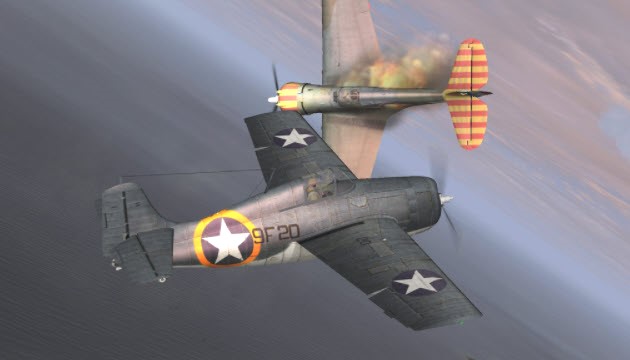
On 10 May 1940, the Germans invaded France, Belgium, Luxembourg and the Netherlands. During Fall Gelb (“Case Yellow”), German panzer divisions made a rapid advance through the Ardennes and then moved through the Somme valley, cutting off and surrounding the Allied forces which advanced into Belgium to counter the advancing German Armies. The Germans pushed the British, Belgian and French forces back to the sea where the British and French navies evacuated the encircled elements of the British Expeditionary Force (BEF) and the French and Belgian armies from Dunkirk during Operation Dynamo.
On June 5, German forces began Fall Rot (Case Red). The remaining sixty French divisions and two British divisions in France made a determined stand on the Somme and Aisne but were defeated by the German combination of air superiority and armor mobility. The German Armies outflanked the intact Maginot Line and pushed deep into France, occupying Paris unopposed on June 14. After the collapse of the French Army, German commanders met with French officials on June 18 to negotiate an end to the hostilities.
On June 22, France signed an armistice at Compiègne with Germany which gave Germany control over the northern and western areas of the country, including Paris and all of the Atlantic coastline, but left the rest, around two-fifths of France’s territory, unoccupied. Vichy France became the common name of the French State headed by Marshal Philippe Pétain. Officially independent, it adopted a policy of collaboration with Germany. Although Paris was still the capital, the Vichy government was established in the resort town of Vichy in the unoccupied “Free Zone”, where it remained responsible for the civil administration as well as the military and all of France’s colonies.
Many squadrons of the French Armée de l’Air (Air Force) were evacuated to French North Africa before the 22 June 1940 Armistice was signed to avoid capture by the Germans. Many aircraft that could not fly were destroyed by their crews.
All Vichy French aircraft had a white outlined added to the fuselage roundels with a white fuselage stripe. From mid-1941 on, red and yellow stripes were added to the engine cowling and tail surfaces. The French named the stripes “Slave’s Pajamas” as the Vichy government was considered a “slave” to Germany. Officially, Vichy France was “neutral” like Sweden and Switzerland. The bright markings were “anti-camouflage” and supposedly prevent them from being fired upon similar to the red and white stripes on Swiss aircraft. Vichy France’s so called “neutrality” unexpectedly had changed in November 1942.
Morocco 1942
Like most of the French forces in North Africa, the air crews had a strong loyalty to their homeland and harbored mixed emotions towards their German conquerors as well as former allies. Many of the pilots had fought the Germans during the battle of France in 1940 and now they are suppose to fight for the Germans. The British concern that the French Vichy forces becoming active opponents caused a number of early confrontations at Mers El-Kebir (3 July 1940), Dakar (24-25 September 1940), Damascus (18–21 June 1941), Syria–Lebanon (June–July 1941) and Madagascar (May 1942). The Vichy French, retaliating against British incursions in North Africa, did staged a bombing raid against the fortress of Gibraltar which caused only minor damage.
For the Vichy French forces in Morocco and Algeria, the desire to remain neutral had more to do with the protection of their families and friends and the preservation of the unoccupied “Free Zone” in France. The Allies did made many political attempts to woo the Vichy French government and their territorial armed forces to the Allied cause to no avail.
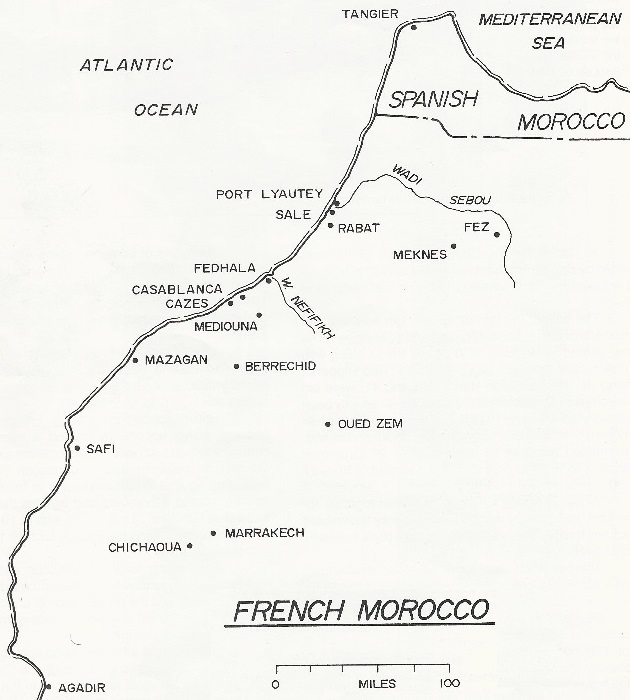
Total Vichy French Air Strength in Morocco
46 Curtiss H75A
40 Dewoitine D.520
26 Douglas DB-7
13 Martin 167 Maryland
39 Loire 451
13 Potez 63.11
31 various transports
208 Total
Units of the French Armée de l’Air were designated by groups:
GC – Groupe Chasse (pursuit or fighter)
GB – Groupe Bomber
GR – Groupe Reconnaissance
GT – Groupe Transport
Squadrons were designated by the proceeding roman numeral.
Example: GC II/5 would be the second escadrille (squadron) of Groupe 5.
The French Naval Air (Aeronavale) parent unit was a flotille consisting of two escadrilles.
Vichy French Aerial Order of Battle in Morocco
| Station | Units | Types | Number |
|---|---|---|---|
| Casablanca | GC II/5 (Lafayette) | Curtiss H75A Dewoitine D.520 | 20 13 |
| Cazes | GB I/32 GT II/15 | Douglas DB-7 Various aircraft | 13 15 |
| Rabat-Salé | GC I/5 GR I/22 GT I/15 | Curtiss H75A LeO 451 Various aircraft | 26 13 16 |
| Port Lyautey | Flo 1F Flo 3F | Dewoitine D.520 Martin 167 | 27 11 |
| Meknes | GB II/23 | LeO 451 | 13 |
| Marrakech | GR I/52 GB I/23 | Potez 63.11 LeO 451 | 13 13 |
| Agadir | Flo 3F GB II/32 | Martin 167 Douglas DB-7 | 2 13 |
Curtiss H75A
The Curtiss H75A was an export version of the USAAC P-36A Hawk fighter. In French service, it was officially designated as the Curtiss H75-C1 (the “Hawk” name was not used in France). The first Hawk 75A-1 (or H75A-1 n°1) was delivered in December 1938 and the type began entering French service in March 1939. France received the following variants up to the 22 June 1940 Armistice.
H75A-1
First production batch, four 7.5 mm (0.295 in) machine guns, R-1830-SC-G engine of 900 hp (670 kW); 100 built.
H75A-2
Second production batch, either R-1830-SC-G or 1,050 hp (780 kW) R-1830-SC3-G engine, six 7.5 mm machine guns; 100 built.
H75A-3
Third production batch, similar to the H75A-2; 135 built (133 delivered).
H75A-4
Last production batch, H75A-2 with Wright R-1820-G205A Cyclone radial engine producing 1200 hp (894.8 kW): 285 built, 81 delivered to France; Britain received the rest as the Curtiss Mohawk IV.
Curtiss H75A-3 of GC I/5
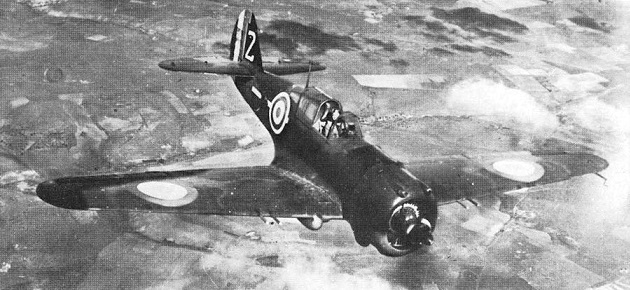
Curtiss H75A-4 n°259 of GC I/5, Rabat-Salé, 1942
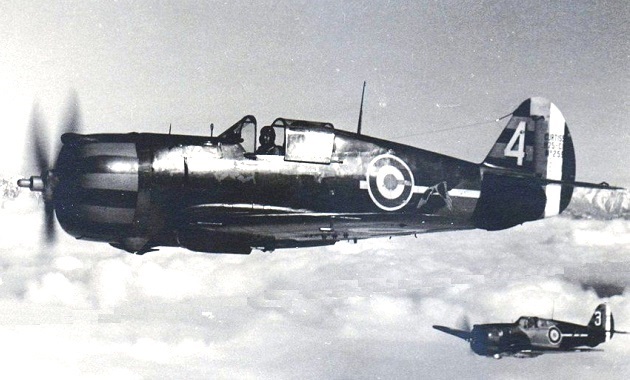
Curtiss H75-C1 n°214 of GC II/5, Casablanca 1942. GC II/5 (heir of the Escadrille Lafayette which fought in France during WWI composed largely of American volunteer pilots) displayed the famous Sioux head on the side of fuselage.
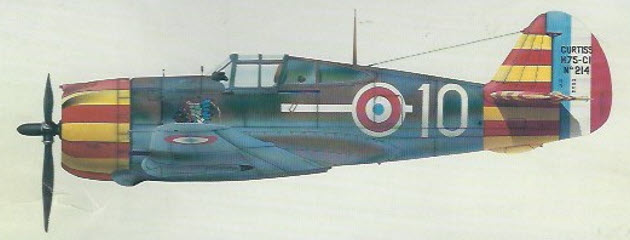
Dewoitine D.520
The Dewoitine D.520 was the creation of Emile Dewoitine. Dewoitine had manufactured several aircraft for the French Air Force in the 1920s and 1930s with the D.510 in 1934. In 1936, Dewoitine setup a new design office. The Air Force required a fighter capable of at least 520 km/h (323 mph), and in January 1937 Dewoitine introduced the new D.520 capable of the required speed but no contract was offered because the Air Force had just introduced the MS.406. In 1937, the French aircraft industry was nationalized and Dewoitine became deputy managing director and he continued to develop the D.520. In 1938, the Ministry of Aviation ordered a couple of prototypes and the first was completed in October 1938. In March 1939, the second prototype reached 527 km/h (327.5 mph) and 200 D.520 fighters were ordered in April.
Specifications
- Main Armament: one 20mm (0.787 in) Hispano-Suiza HS.404 cannon (60 rounds) firing through the propeller hub.
- Four belt-fed MAC 1934 M39 7.5mm (0.295 in) machine guns in the wings (675 rounds per gun).
- Engine: Hispano-Suiza 12Y-49 V-12 liquid-cooled piston engine, 710 kW (950 hp)
- Maximum speed: 560 km/h (350 mph)
- Range: 1,250 km (780 miles)
A Dewoitine D.520 of an unknown unit at Toulouse, Southern France, 1942.
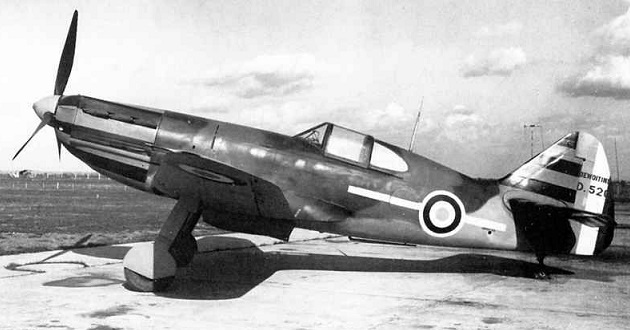
Dewoitine D.520 n°317 of French Aeronavale Flotille 1F flown by Lieutenant de Vaisseau (Navy) Faivre at Port Lyautey, 1942.
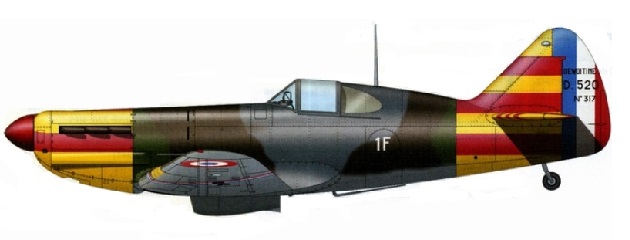
Film: Dewoitine D.520
Douglas DB-7
The Douglas A-20 Havoc was a US medium bomber, attack aircraft, night intruder, night fighter, and reconnaissance aircraft. The French order called for substantial modifications to meet French standards, resulting in the DB-7 (Douglas Bomber 7) variant. It had a narrower, deeper fuselage, two 1,000 hp (750 kW) Pratt & Whitney R-1830-SC3-G radials, French-built guns, and metric instruments. Of the 270 DB-7s ordered, 116 were accepted by the French before the 22 June 1940 Armistice.
DB-7 B3 probably of GB II/32 at Agadir airfield, November 1942.
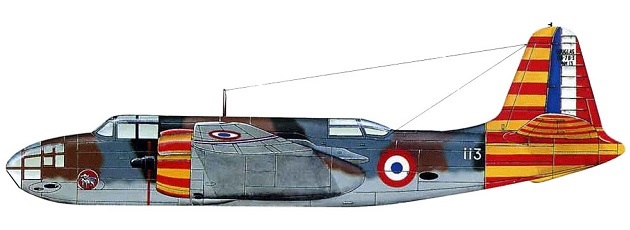
Film: Douglas DB-7 bomber for France under construction in the USA
Martin 167
In response to a USAAC light bomber requirement issued in 1938, the Glenn L. Martin Company produced its Model 167 Maryland (or Baltimore), which received the official designation XA-22. The Martin’s design was a twin-engine all-metal monoplane, capable of around 310 mph (500 km/h) with a crew of three. The XA-22 was not accepted by the US for operational service because the contract was won by the Douglas entry, which became the A-20 Havoc. However, Martin received foreign orders, and about 450 of these fast, twin-engine bombers were built for France and Britain.
The Martin Baltimore factory built 115 aircraft for France in six months, but their delivery was prevented by a US government arms embargo. Despite this the French placed an order for an additional 100 aircraft. After the embargo was lifted in October 1939, the 115 aircraft from the first order were delivered by late November 1939. Deliveries then slowed, and only 25 of the second batch reached France before the 22 June 1940 Armistice.
Martin 167-A3 Maryland of Escadrille 3B, Flotille 3F.
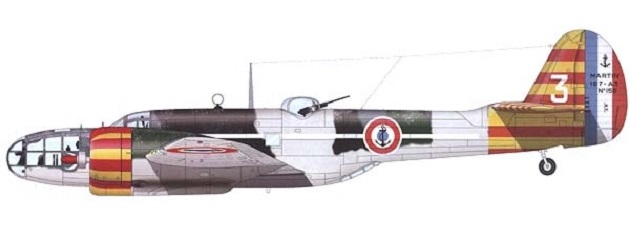
Loire 451
The Lioré et Olivier LeO 451 was France’s best medium bomber introduced in 1937. It was a four-seater twin-engine low-flying aircraft of all-metal construction with covered crew compartments and a retractable landing gear. The vertical tail surfaces were twin, located at the ends of the horizontal tail surface. It was powered by a pair of Gnome-Rhone 14N 48/49 or 38/39 14-cylinder air-cooled, 1060 hp (790 kW) radial engines for a maximum speed of 300 mph (483 km/h) at 13125 feet (4000 m) and was armed with a 20mm Hispano-Suiza HS.404 cannon firing from a dorsal turret, a single 7.5 mm MAC 1934 in a “dustbin” retractable ventral turret, and one fixed-forward firing 7.5mm machine-gun.
A LeO 451 probably belonged to GB I/23 at Marrakech in November 1942.
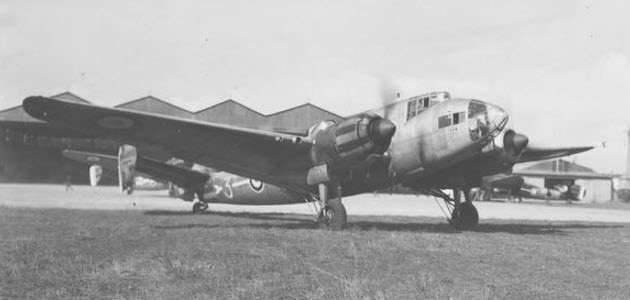
Film: Production of a bomber Liore et Olivier LeO 451, France 1940
Potez 63.11
A modified version of an earlier reconnaissance aircraft, the Potez 637, the Potez 63.11 flew for the first time on 31 December 1938. It had a completely redesigned forward fuselage that included an angular glazed nose section. Between November 1939 and June 1940, the Armee de l’Air took delivery of 723 Potez 63.11s. After the 22 June 1940 armistice, surviving aircraft saw extensive service with both Free French and Vichy forces. In 1942, many were used by the Luftwaffe for training and liaison duties.
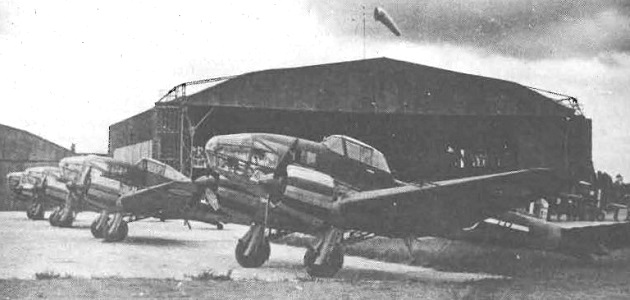
Operation Torch 1942
It was the first combined Allied amphibious operation, and while successive ones would dwarf this operation, none surpassed it in complexity, in daring or the hazards involved. Two Allied naval task forces were assembled for the invasion along with ground forces that numbered about 107,000 troops. However, the necessity of assaulting several widely dispersed beachheads fragmented this formidable force. The Eastern Task Force landing at Algiers and the Central Task Force landing at Oran had the Royal Navy transporting US and British ground forces and providing the air cover. Both the Algerian task forces were assembled in the UK and staged through the British fortress at Gibraltar at the mouth of the Mediterranean Sea.
The invasion of French Morocco, 500 miles (804.7 km) to the west on Africa’s west coast was an all US operation where, in its initial stages, trans-versed 4500 miles (7242 km) through enemy submarine infested waters. As it approached the North African coast, the Western naval armada, Task Force 34, split into two, sending one battle group toward the Casablanca area and a separate battle group south to land troops at Safi. The main landing force further divided itself into central and northern groups to strike at two locations north of Casablanca at Fedhala and Mehedia.
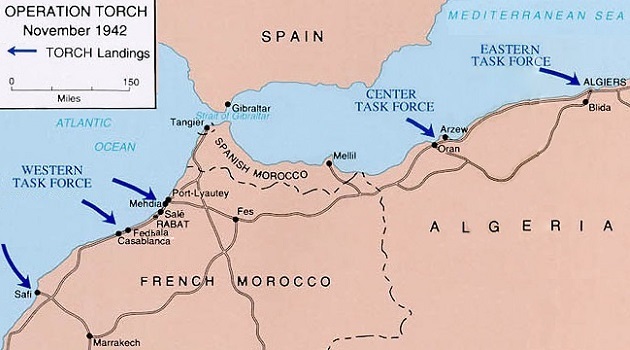
Film: America Invades Africa – France Fights Back
US Navy Naval Aerial Order of Battle
The US Navy main combat aircraft at the time was the Grumman F4F-4 Wildcat fighter, Douglas SBD-3 Dauntless (“Scout Bomber Douglas”) and the Grumman TBF-1 Avenger torpedo bomber.
TASK FORCE 34
CV-4 USS RANGER
Air Group 9: 1 TBF-1, CAG
VF-9 “Cat o’ Nines”: 27 F4F-4s
VF-41 “Red Rippers”: 27 F4F-4s
VS-41 “High Hats”: 18 SBD-3s
ACV-26 USS SANGAMON
VGF-26: 12 F4F-4s
VGS-26: 9 SBD-3s, 9 TBF-1s
ACV-27 USS SUWANNEE
VGF-27: 11 F4F-4s
VGS-27: 9 TBF-1s
VGF-28: 12 F4F-4s
VGS-30: 6 F4F-4s
ACV-29 USS SANTEE
VGF-29: 14 F4F-4s
VGS-29: 9 SBD-3s, 8 TBF-1s
ACV-28 USS CHENANGO
USAAC 33rd FG: 76 P-40Fs
Auxiliary carriers SANGAMON, SUWANNEE, SANTEE and CHENANGO were newly minted, hurriedly converted from tanker hulls and these “Jeep” carriers scarcely had time for a proper shakedown prior to joining Task Force 34.
After shakedown, the SANTEE departed Bermuda on October 25 and headed for the coast of Africa. While en-route on October 30, a SBD-3 Dauntless being launched from a catapult dropped a 325 lb (147 kg) depth charge bomb onto the flight deck. It rolled off the deck and detonated close to the port bow shaking the entire ship, carrying away the rangefinder, a searchlight base, and damaging radar antennas. Nevertheless, the SANTEE continued steaming and join up with Task Group 34.
The SANGAMON provided air cover for the northern attack group while the CHENANGO also sailing with the northern attack group carried a full flight and hanger decks packed with USAAC Curtiss P-40F Warhawks. Air cover for the southern attack group was provided by the SANTEE while the bulk of the carrier air strength was with the central attack group aboard the RANGER and the SUWANNEE. While the RANGER’s air group had existed for some time, neither they or the more recently formed squadrons had yet been tested in combat. The VF-41 “Red Rippers” and the VS-41 (Scouting 41) “High Hats” were old squadrons with proud naval heritages but VF-9 had only been commissioned in March 1942. All three squadrons on the RANGER did had experienced naval pilots.
Grumman F4F-4 Wildcats of VF-9 and VF-41 testing their guns on board the RANGER en-route to North Africa. The closest three F4F-4s belonged to VF-9 numbers 20, 9 and 18 while the furthest three F4F-4s belonged to VF-41 numbers 22, 21 and 25. Note the small deck tractor in the foreground.
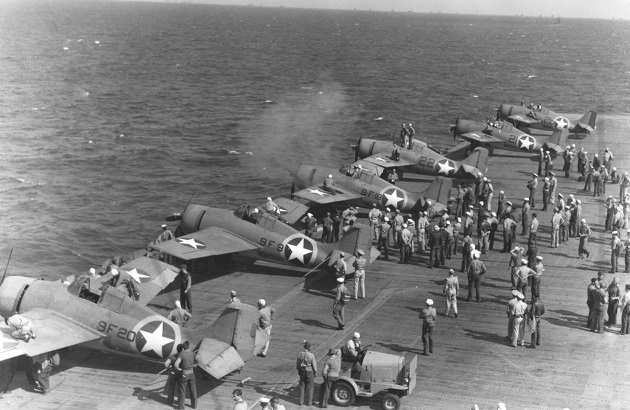
This is my close up of VF-41 F4F-4 number 22 which was flown by Lt. (j.g.) Charles Alfred “Windy” Shields.
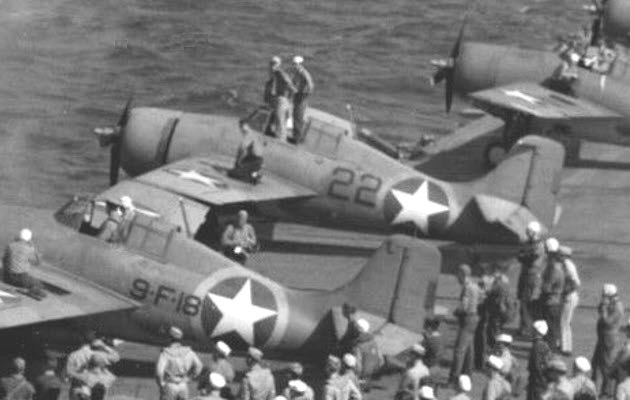
F4F-4 Wildcat “9-F-25” of VF-9 revving up for take off from the RANGER. Note the two US Army Piper L-4 spotter planes flying overhead.
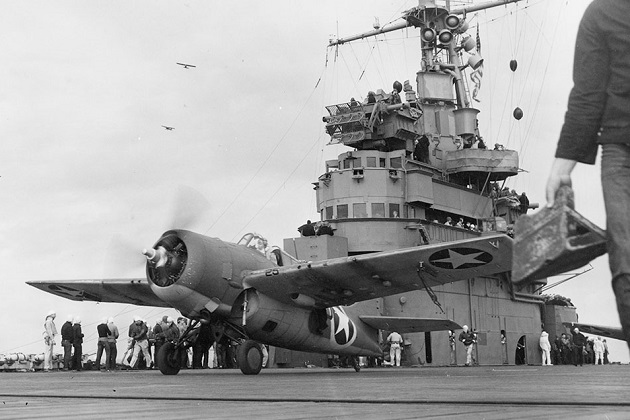
Flight deck crews position a Douglas SBD-3 Dauntless of VS-41 on the RANGER.
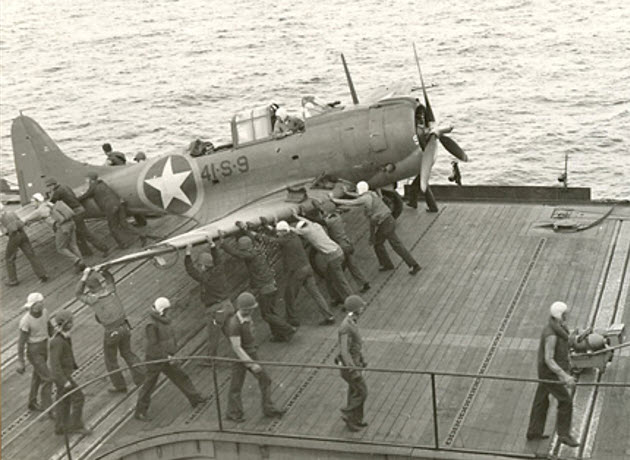
Three Grumman TBF-1 Avenger torpedo bombers are revving up in front with F4F-4s and SBD-3s behind them. This carrier was either the SANTEE or the SANGAMON both of which carried squadrons of all three aircraft types.
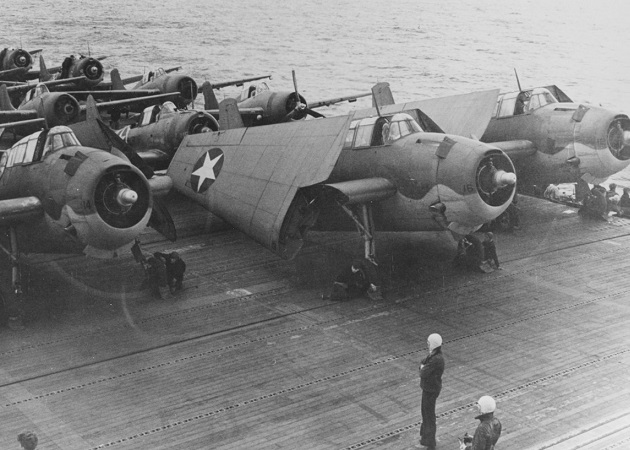
Douglas SBD-3 Dauntlesses of VGS-26 on the left and Grumman F4F-4 Wildcats of VGF-26 are spotted tightly on the flight deck of the SANGAMON. Distances and other target information for the aircrews is chalked on the deck.
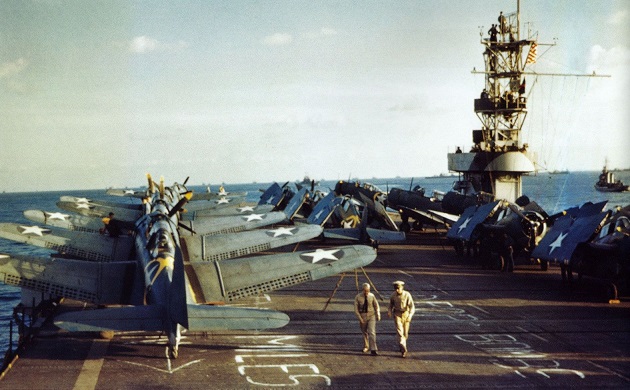
November 8
The approach of the great US naval armada was incredibly undetected. US landing craft hit the beaches well before dawn. The French squadrons were not alerted until the simultaneous naval barrage from the sea and a leaflet drop over Casablanca, the former announced the US intentions and the former offered a peaceful resolve. At 0630 hours, the French had sounded alert sirens at their scattered barracks and airdromes. Their various military units were called to arms with no thoughts of surrender.
At 0610 hours, VF-9 was launched from the RANGER with its CO, Lieutenant Commander John Raby leading 9 F4F-4 Wildcats towards Rabat Airdrome. Unopposed, they made three line abreast passes destroying many French aircraft on the ground. A second 8 plane section of VF-9 followed closely, providing top cover for Raby’s strafers. Encountering no aerial opposition, Lieutenant Hugh Winter then led his section in five strafing passes at nearby Salé Airdrome concentrating on French bombers and several defense emplacements. French sources indicated that 24 bombers and 3 Farman transports were lost in the combined strafing attacks by VF-9.
This Curtiss H75A n°298 “2” of GC I/5 was destroyed on the ground at Rabat-Salé.

The battleship USS MASSACHUSETTS BB-59 was assigned to Task Force 34 and was tasked with neutralizing the primary French shore defenses. The Massachusetts carried three Vought OS2U-3 Kingfisher observation/scout seaplanes which were catapulted for gunnery observation. Catapult launched aircraft from US heavy cruisers were a mix of OS2U-3s and aging Curtiss SOC Seagull biplanes. At 0740 hours, GC II/5 Lafayette dispatched two three plane flights from Cazes Airdrome. Over Casablanca, they encountered several US Navy observation planes. Curtiss H75As, led by Lieutenant Villacque, intercepted the spotting mission and the US Naval spotter planes retreated towards the protection of the fleet. Heavy AA fire from the US warships forced the French fighters to break off their pursuit but not before Sergeant Lavie shot down a OS2U-3 from the MASSACHUSETTS.
VF-41’s first section of 18 Wildcats launched from RANGER around 0700 hours led by CO Lieutenant Commander Tom Booth. Followed closely behind was the remainder of the RANGER’s fighter strength, 8 planes from each of the Wildcat squadrons. This final section was led by Lieutenant “Mac” Wordell of VF-41. Booth’s section was ordered to attack Cazes Airfield while Wordell’s section was assigned to provide air cover over the transports and landing crafts near the Fedhala beachhead.
While the Wildcats were approaching, the French were simultaneously launching additional fighters from their airfields as the French pilots reported in. GC II/5 got three fighters airborne at 0800 hours and three more at 0830 hours. After that they scrambled individually and inevitably all engaged in aerial combat with VF-41.
Lieutenant (j.g.) Charles Alfred Shields and Lieutenant (j.g.) C. V. August of VF-41 got into a dogfight with GC II/5 Dewoitines and Curtiss Hawks over Cazes. During the melee, Lieutenant August, his Wildcat damaged, was being chased by two French Hawks at low level over Cazes. Lieutenant Windy Shields, in Wildcat #22, came to the rescue and broke up the attack. August managed to shoot down two Curtiss Hawks before his Wildcat died forcing him to bale out and he became a POW. During the engagement, Windy Shields downed a Dewoitine and a Curtiss Hawk. He was about to return to the carrier when a Curtiss Hawk dived out of the sun and riddled his Wildcat. Shields parachuted from his smoking Wildcat. He landed on a barbed-wire fence and also became a POW.
SBD-3 Dauntlesses of VS-41 shuttled between the RANGER and various shore targets but concentrated their initial efforts on the active French naval vessels, then turned their fury on the French battleship JEAN BART. The incomplete French battle wagon was at berth in Casablanca harbor protected by torpedo nets and was unable to leave the pier. But even immobile, its four 15 inch guns along with eight large coastal mortars at Batterie El Hank, proved to be a threat to the US invasion forces. Repeated air attacks by VS-41 silenced the JEAN BART but not before AA fire hit three SBD-3s.
The second trip to the Cazes Airdrome was led by Lieutenant Cagey Hammond of VF-41. The Wildcat pilots were astonished to spot Douglas DB-7 bombers being serviced on the field without any fighter cover. The F4F-4s dived on the airfield in pairs with all guns blazing. After the air attack, the airfield was a pathetic sight. It looked like a child’s toy after the little owner had become displeased with it, and had peevishly stomped on the planes. Burning and riddled planes littered the airfield.
Douglas DB-7 bombers destroyed on the ground probably at Cazes.

A Dewoitine D.520 of an unknown unit destroyed on the ground.

Crash Landing
The entire tail section of Ensign Joe Gallano’s F4F-4 of VGF-29 was torn off by the arresting cable on the SANTEE off the coast of Safi. In a dogfight, Dewoitines probably riddled Gallano’s tail with 20mm fire.

The markings on Gallano’s F4F-4 was “29-GF-10” with the “10” painted white.
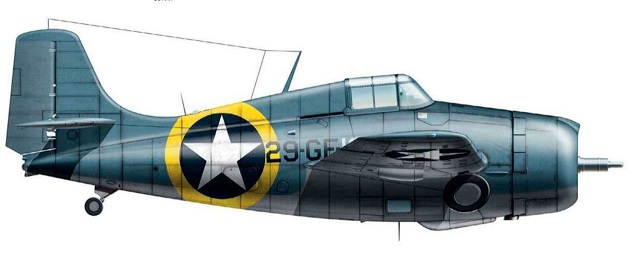
Gallano’s F4F-4 continued down the flight deck and begins to nose over. Note the black “10” painted on top of the wings.
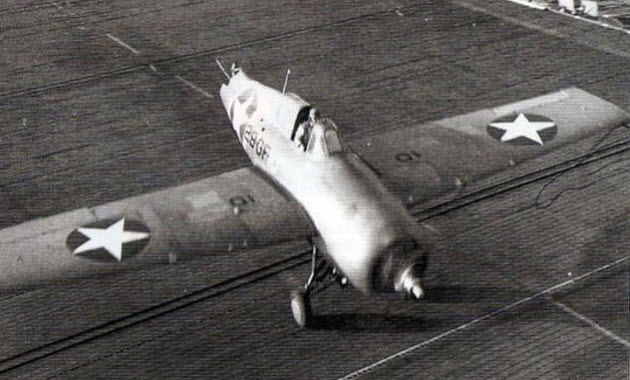
Gallano’s F4F-4 nosed over and stopped near the carrier’s island. Gallano was only slightly injured.
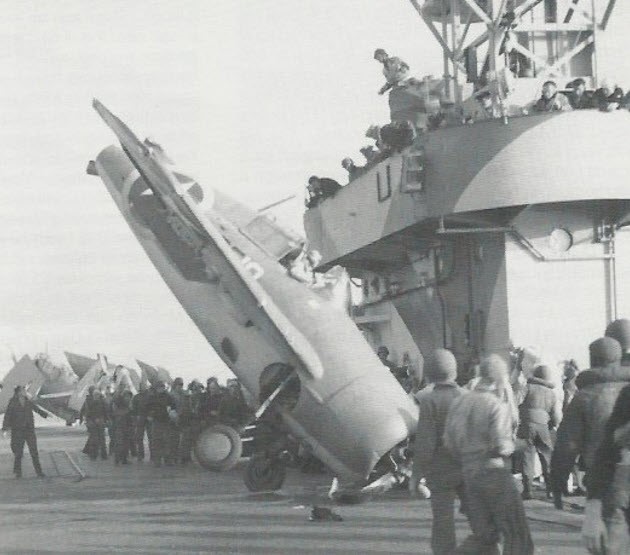
Due to limited space on the SANTEE, Gallano’s tailless F4F-4 was pushed overboard.
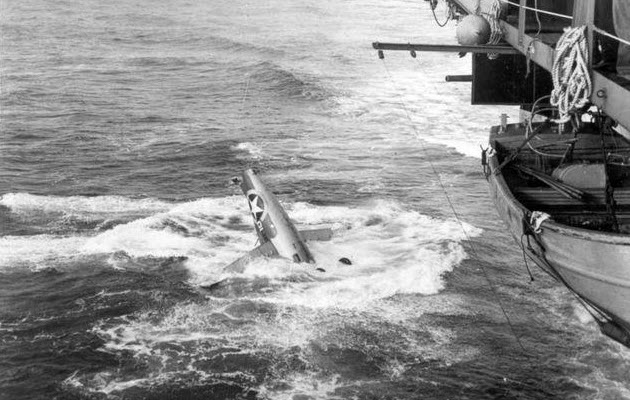
The RANGER at the end of the first day off the Morocco coast with two F4F-4 Wildcats, wings folded on the edge of the flight deck. The rest of the planes are below on the hanger deck being repaired and readied for maximum effort in the morning. The aircrews are sleeping (that is if they are able to).
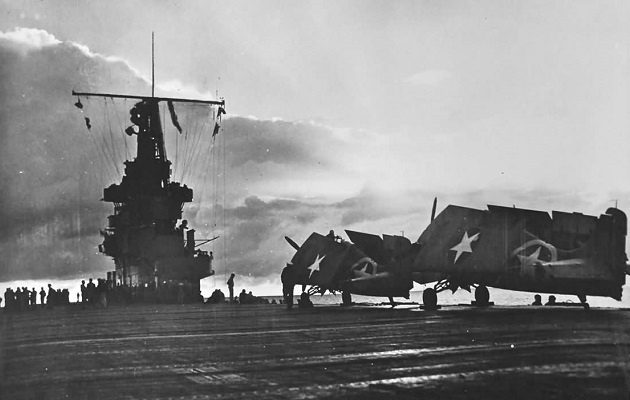
November 9
The battered but plucky pilots of GC II/5 were airborne at dawn with only five aircraft. They strafed landing craft at Fedhala and received such intense US Navy AA fire that three of the French Hawks were damaged severely, although all the planes returned.
At 0645 hours, Tom Booth leading 7 Red Ripper Wildcats took off from the RANGER bound for Port Lyautey. John Raby’s VF-9 was close behind with eight F4F-4s ordered to patrol over Fedhala.
The VF-41 pilots were straining to locate enemy targets and waiting for some direction when an air control officer with US troops radioed that a lone French plane was strafing them. Tom Booth replied to the distress call but was immediately countermanded by the ship and ordered to attack an enemy transport column on the Fedhala-Casablance Road. In screaming dives, the Wildcats descended on the enemy truck convoy spraying it with .50 Cal machine gun fire. Booth ordered the stubby Wildcats to strafe the column again. While pulling up, they observed 6 to 8 trucks burning and another half dozen sitting at odd angles in the ditches along the chaotic road.
John Raby’s VF-9 had barely reached their patrol altitude at 10,000 feet when French aircraft were spotted. A motley group of 15 LeO 451s, DB-7s and Martin 167s had just bombed landing craft on the Fedhala beachhead from high altitude with poor results. They were escorted by 16 Hawk 75s from GC I/5. Without the slightest hesitation, Raby led his 8 Wildcats against the enemy force. The French bombers got away as the fighters became embroiled in a massive dogfight.
In the air battle, Wildcats and Hawks alternately became the hunter and were the hunted. The French fought and flew courageously, but the Curtiss fighters were unable to cause decisive damage to the Wildcats. On the other hand, the six .50 Cal machine guns of the F4F-4s had a devastating effect on the French fighters. Some of the French pilots had out flown the Wildcats, but they did not ready had a chance. The main reason may have been that their aerial combat tactics were those from WWI. Four planes of the Champagne Escadrille were destroyed, two pilots KIA and two other survived crash landings. Another four Hawks were damaged. VF-9 claimed 5 destroyed and 4 probables.
November 10
The Vichy French air strength had been so depleted during the first two days of fighting that none of their fighters rose to resist the US Navy on November 10. The Lafayette Escadrille had suffered such severe losses that they received reinforcements from GC I/3 stationed inland at Fez. The lack of enemy aerial resistance permitted the US Navy carrier planes to concentrate on close ground support.
A flight of VF-41 Wildcats was flying over the Cherrat River and below them US trucks and troops were advancing along the road to Rabat, preceded by scout cars, tanks and motorcycles. On receiving a warning from ground intelligence that Vichy forces were were moving along the road from Bouznika and the Nefifikh River, the flight attacked the enemy column and strafed 15 to 20 vehicles. After they departed the area, all the enemy tanks in the column were stopped.
Late on the 10th, when French tanks threatened the advance near the Port Lyautey-Rabat Road, Lieutenant R. Y. McElroy led a mixed force of 12 TBF-1s and SBD-3s in an attack. On the approach of the VGS-26 formation, the French armor hunkered down in a grove of Eucalyptus trees. Behind this protective screen and with their excellent camouflage, the armored vehicles were extremely difficult to spot other than flying at tree top level. McElroy led his planes in repeated low level runs, first bombing then strafing, destroying or damaging several vehicles which turned back the French counterattack. Ten escorting Wildcats of VGF-26 flying top cover also joined in the strafing. Several planes took hits from heavy ground fire but all returned to the carrier safely.
Safi Airfield
During November 9-10, US planes from the SANTEE either low on fuel or had battle damage landed on a small auxiliary RAF airfield near Safi which was then under Allied control. A few of the F4F-4s were ordered by SANTEE to land at Safi for refueling as a matter of convenience to the ship which had suspended flight operations to fuel a cruiser. The airfield, confined, short, and made muddy by recent rains was an unwelcome port in a storm. The muddy runway caused most of the planes to nosed over or bogged down. Over a dozen disabled SANTEE planes were spread across the airfield.
This is an aerial photo of the airfield. Note the tire tracks around the planes and the tree lined road in the background.
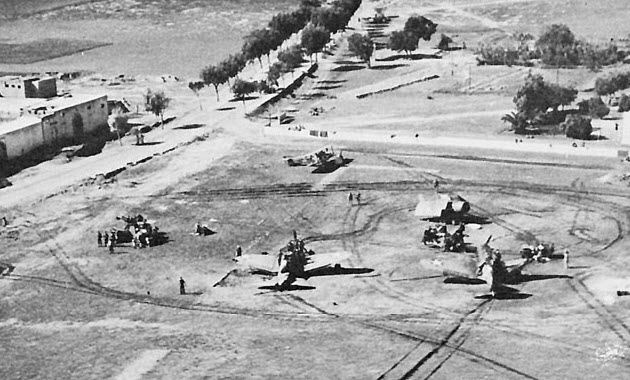
In this photo, a TBF-1 Avenger (upper left), two SBD-3 Dauntless dive bombers and a F4F-4 Wildcat (with folded wings) can be seen. Note the large stars with yellow circle and the US Jeep parked in the middle of them.
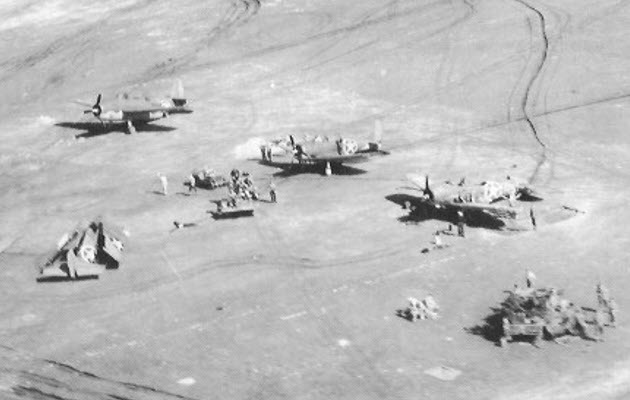
Personnel of the US Marine Corps detachment from the USS Philadelphia (CL-41) Brooklyn-class light cruiser was sent to the airfield to help with the service and recovery of the planes. US marines and soldiers inspecting a nosed over F4F-4 Wildcat. The code on the fuselage side is “29-GF-9”, the white 9 is the plane number.

In this photo, the men are carefully lowering the Wildcat’s tail back to the ground while the pilot stand by watching.
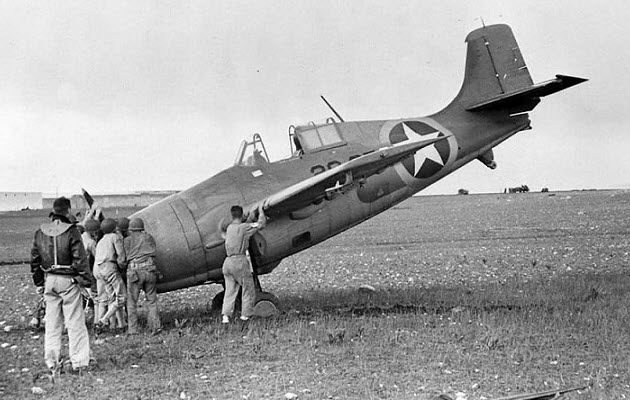
Soldiers are laying matting on the runway in front of this TBF-1 Avenger. The Avenger has a small black 10 just below the propeller hub. In the background is another plane flipped over on its back. Note the ruts in the mud.
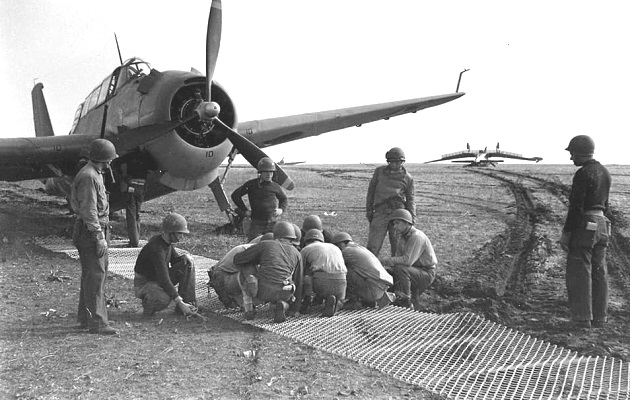
On landing, the right landing gear of this SBD-3 Dauntless had collapsed and propeller blades got bent up striking the ground.
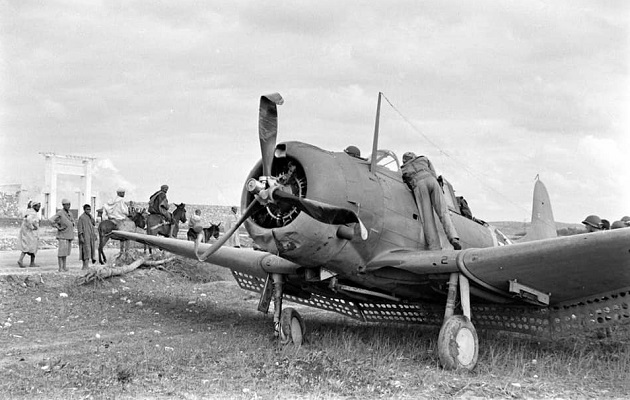
A TBF-1 Avenger is parked in front of a building. The left wing is folded and the right wing appears to be folding or is damaged. The code “29-GS-13” is on the fuselage. This plane was not so lucky to land at Safi.
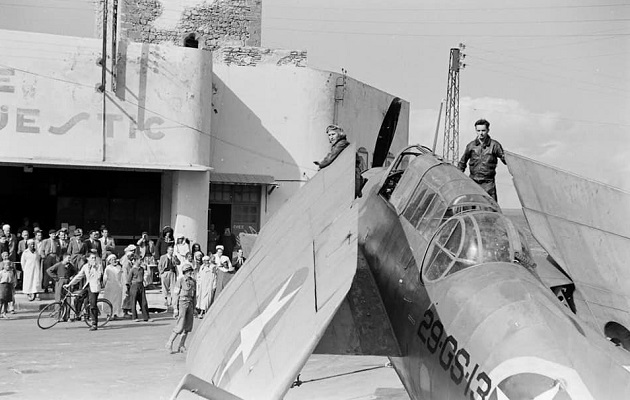
Fuel and spare parts were brought in and only 5 planes were able to be made flyable. On November 10, a bulldozer cleared the trees from the edge of road section to be used as a runway and the work was completed the next morning.
This SBD-3 Dauntless is taking off along the road.
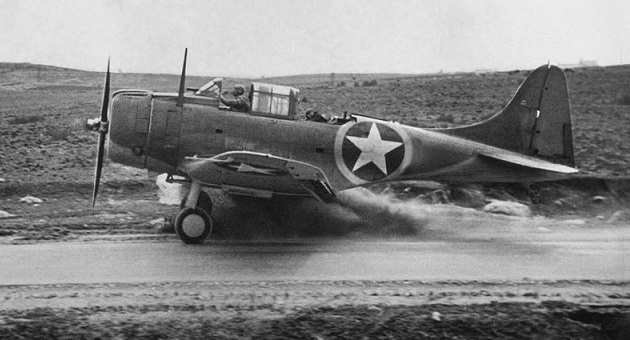
This is a rear view of the Dauntless taking off. Note the pushed over tree along the side of the road on the right.

Due to wind sweeping across the road, only 2 of the 5 planes were able to take off and return to the SANTEE. The remaining planes were left behind and were scrapped.
This is a view of the same Dauntless taking off passing an unlucky Dauntless which the wind blew off the road and nosed over in the soft ground.

This is another view of the nosed over Dauntless on the side of the road-runway. What a pity. The Dauntless was repaired to fly only to be damaged again then probably scrapped.
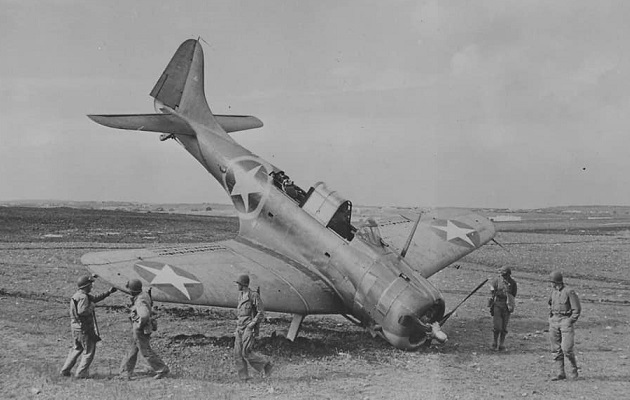
This is another Dauntless revving up preparing to take off down the road-runway. A ground crewman sitting on the wing help guide the pilot to position his plane on the narrow road and monitor the wind direction.
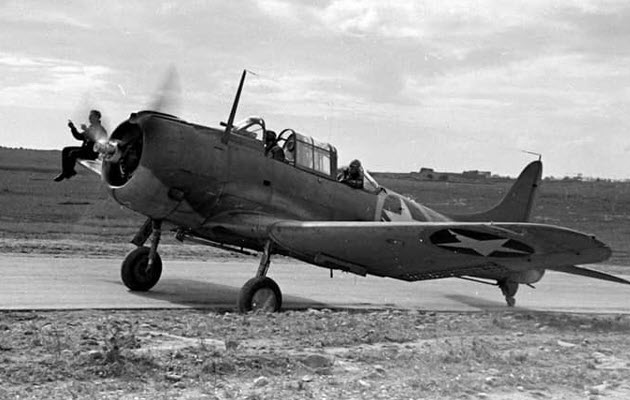
JEAN BART
The French battleship JEAN BART was laid down in 1936 and was launched in 1940, following the outbreak of WWII in Europe. The ship was not complete by the time Germany won the battle of France, and the JEAN BART sailed to Casablanca to escape the advancing German troops. She had only one of her main turrets installed, along with a handful of anti-aircraft guns. While berthed in Casablanca, the French attempted to prepare the ship for action as much as was possible in light of limited infrastructure and lack of necessary parts to complete the ship. Her anti-aircraft armament was slowly strengthened as guns became available and a search radar was fitted in 1942.
When the US forces invaded on November 8, the JEAN BART initially helped to resist the invasion, engaging in a gunnery duel with the USS Massachusetts battleship. Despite the numerous shell and aerial bomb hits, the French battleship was not seriously damaged.
Video: Jean Bart vs. USS Massachusetts
On November 10, the RANGER launched a final air strike on the JEAN BART. Nine VS-41 SBD-3 Dauntlesses, armed with 1000 lb (450 kg) bombs, and eight F4F-4 fighters attacked the French battleship at 1500 hours. The F4F-4s strafed Jean Bart’s anti-aircraft batteries to suppress them for the Dauntless dive bomb attacks. Two of the dive bombers scored hits; the first caused extensive damage to the forecastle and the second destroyed a substantial part of the hull toward the stern.
Aerial view of the JEAN BART at her berth after the battle. Note the bomb damaged sheds on the adjacent pier and the torpedo nets protecting the trapped battleship.
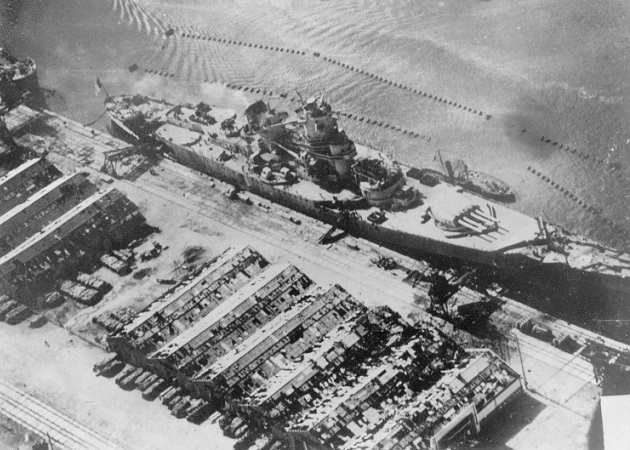
This is a close up of the damage to the starboard stern of the JEAN BART from a direct hit from a VS-41 Dauntless.
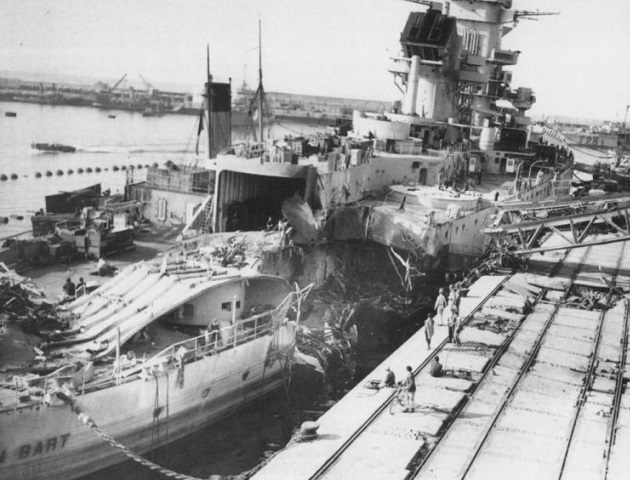
Film: Damaged Jean Bart, a French battleship in Casablanca Harbor
P-40 Warhawks
As part of the invasion fleet, the USS CHENANGO transported the P-40F Warhawks of the USAAC 33rd Fighter Group (58th, 59th and 60th Fighter Squadrons). The P-40F was fitted with a British supercharged Rolls-Royce Merlin engine which had better performance at high altitudes but these fighters did not take part in the air battle against the Vichy French. The P-40Fs were not capable of making carrier landings so after launching it was a one way trip to an airfield on shore.
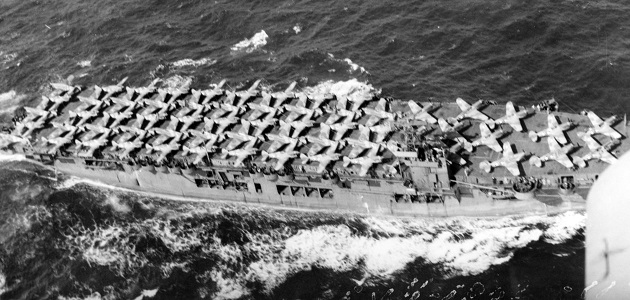
After airfields were secured on November 10, the P-40F Warhawks flew from the CHENANGO to Port Lyautey to form an aerial defense force. They were equipped with 75 gallon (283.9 Liter) drop tanks mounted under the fuselage.

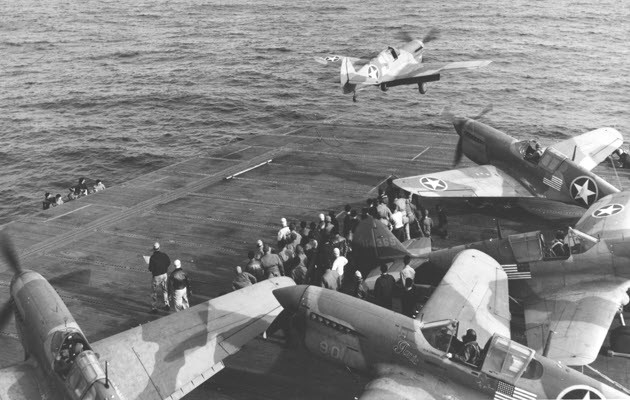
P-40F #90 in the foreground, named “Janie”, was flown by Lt. Robert J. Palenscar of the 60th Fighter Squadron. To the right of “Janie” are two more P-40Fs, serial numbers 41-14365 and 41-14333. Note the 48 state US flags (6 rows of 8 stars) on the fuselages.

Film: Air Action in North Africa in 1942-43 – P-40 aircraft Operation Torch
ARMISTICE
On 11 November 1942, Vichy French forces in North Africa signed an armistice with the Allies. Peace negotiations, the US Army went thru pains not to call it a surrender. Dawn strikes, support missions and CAPs from the US fleet barely reached the Morocco coast when the carriers radioed the “cease fire” signal.
The ill-fated SANTEE, however, had a busy day as the news of the armistice seemed to have missed them. At 0745 hours, a mini-raid composed of one F4F-4 and one SBD-3 of Air Group 29 attacked Marrakech airdrome burning three Potez 63.11s and a hanger.
The French released the US Navy POWs which was probably the shortest captivity period of the war. They returned to their units or were sent to new assignments.
Before returning to the RANGER, Chuck August had the opportunity to inspect Cazes Airdrome and chat with some of the French pilots which he had fought against. The French pilots who were on duty came hurrying out to meet him, some wearing flying gear and some in blue uniforms with gold rank bars. Some of them spoke a little English. They were mostly cheerful and curious about him. They asked what type of plane he was flying, where he came from, and particularity how many pilots the US Navy lost. He told them as far as he knew he was the only one, and they looked a bit glum. Lieutenant Villaceque was quite frank, even though August was his prisoner. He said he sent 18 planes up, had seen 6 of them crashing, and only 4 returned to the field. Eight of them had not been heard from again. One young French pilot was in tears. He had seen three of his comrades shot down, and he landed with a plane full of holes. The french pilots did not seem enthusiastic about fighting the Americans or fighting for the Vichy government, but they were hurt that they had been vanquished so quickly.
Despite the cessation of hostilities in Morocco, action at sea remained active through November 11 and 12. German submarines boldly attacked the US invasion fleet. German torpedoes were repeatedly fired at RANGER, SUWANNEE, CHENANGO and crusier BROOKLYN but all missed thanks to desperate maneuvering by the surface ships.
As a consequence of the Allies success in North Africa, the Axis launched Operation Anton which invaded unoccupied France marking the end of the Vichy regime as a nominally-independent state. This action caused all French military units in North Africa to join the Free French Forces.
Repair work on the battered JEAN BART eventually made her seaworthy again and for the remainder of the war, the JEAN BART was used as a training ship. Many of the French sailors who wanted to fight the enemy left their ships. Some ended up joining the Régiment Blindé de Fusiliers-Marins (RBFM) where a US built M10 Tank Destroyer named “JEAN BART” crewed by ex-French sailors destroyed a German Panther tank on 12 August 1944.
Armée de l’Air Rebirth
Like the proverbial phoenix, the French Armée de l’Air rose from the wreckage of Operation Torch. Many French aviation units were reformed. The Bomber Groupes were re-equipped with US Martin B-26 Marauder medium bombers. Four transport escadrilles received Douglas C-47 cargo planes and the Reconnaissance Groupes received Lockheed F-5 Photo Lightnings. The Chasse Groupes (fighters) received British Spitfires, Bell P-39Airacobras, Curtiss P-40 Warhawks and later Republic P-47 Thunderbolts. GC I/5 was re-equipped with P-39s and later P-47s. GC II/5 Lafayette was provided first with P-40s and finished the war with P-47s. Both escadrilles served to the end of the war with records of distinction which mitigated the bitter memories of what their unit histories called “the black days” of November 1942.
On 9 January 1943 at Casablance, a ceremony officially transferred 12 ex-USAAC Curtiss P-40F Warhawk fighters to the Lafayette escadrille GC II/5.
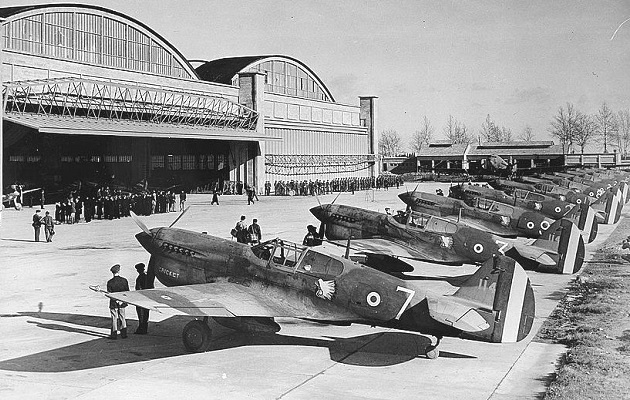
This is my close up of P-40F number 7. The name on the engine cowling appear to be “CRICKET”.
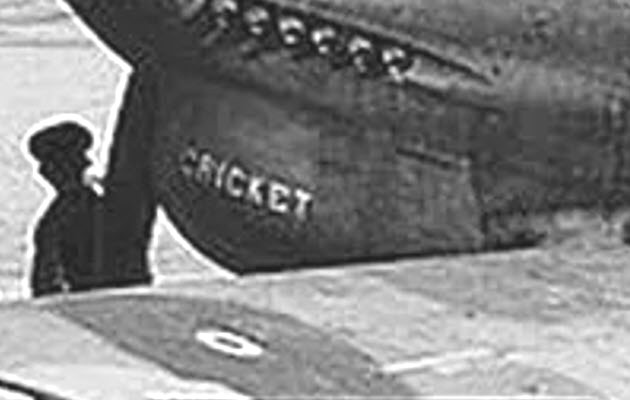
This is a color photo of the same planes. The yellow numbers “114” are the first three digits of the US serial number. The french blue/white/red stripes on the rudder was painted over the rest of the serial number.
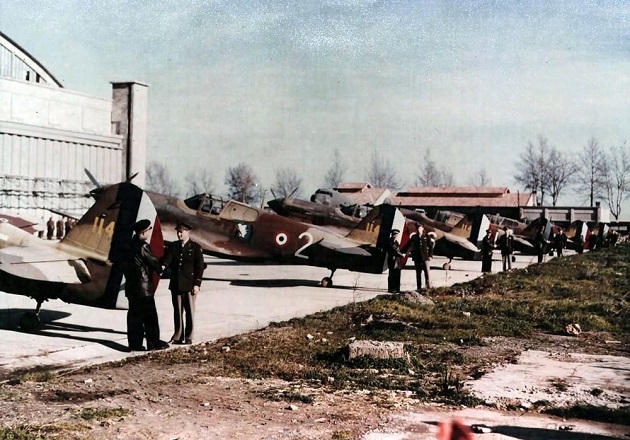
Film: Presentation of Curtiss P-40 Warhawk planes to the French
US Navy Aerial Combat Claims
| Pilot Name | Date | Squadron | Claims |
|---|---|---|---|
| Lt. (j.g.) C. V. August | November 8 | VF-41 | 2 H75As Destroyed |
| Lt. Cdr. C. T. Booth | November 8 | VF-41 | 1 H75A or De.520 Destroyed |
| Ens. A. B. Conner, Jr. | November 8 | VF-41 | 1 H75A Destroyed |
| Lt. M. M. Furney | November 8 | VF-41 | 2 H75A or De.520 Destroyed |
| Lt. T. A. Grell | November 8 | VF-41 | 1 De.520 Probable |
| Lt. (j.g.) G. M. Harris | November 8 | VF-41 | 1 De.520 Destroyed |
| Lt. (j.g.) B. N. Mayhew | November 8 | VF-41 | 2 H75A or De.520 Destroyed |
| Lt. L. F. Palmer, Jr. | November 8 | VGF-26 | 1 Martin 167 Destroyed |
| Lt. Cdr. J. Raby | November 8 | VF-9 | 1 LeO 451 Destroyed (*) |
| Lt. (j.g.) Charles Alfred Shields | November 8 | VF-41 | 1 H75A Destroyed |
| Lt. (j.g.) Charles Alfred Shields | November 8 | VF-41 | 1 De.520 Destroyed |
| Ens. W. Taylor | November 8 | VF-41 | 1 H75A or De.520 Destroyed |
| Lt. E. W. Wood, Jr. | November 8 | VF-41 | 1 De.520 Destroyed |
| Lt. K. C. Childers, Jr. | November 9 | VF-9 | 1 H75A Destroyed |
| Lt. K. C. Childers, Jr. | November 9 | VF-9 | 1 H75A Probable |
| Ens. M. J. Franger | November 9 | VF-9 | 1 H75A Destroyed |
| Ens. M. J. Franger | November 9 | VF-9 | 1 H75A Probable |
| Ens. L. A. Menard | November 9 | VF-9 | 1 H75A Destroyed |
| Ens. L. A. Menard | November 9 | VF-9 | 1 H75A Probable |
| Lt. Cdr. J. Raby | November 9 | VF-9 | 1 H75A Destroyed |
| Lt. Cdr. J. Raby | November 9 | VF-9 | 1 H75A Probable |
| Lt. (j.g.) H. E. Vita | November 9 | VF-9 | 1 H75A Destroyed |
| Lt. Ernest W. Wood, Jr. | November 9 | VF-41 | 1 De.520 or Me109 Destroyed (**) |
| Ens. B. D. Jaques | November 10 | VGF-29 | 1 Potez 63.11 Destroyed |
| Ens. D. A. Pattie | November 10 | VGF-29 | 1 DB-7 Destroyed (a Potez 63.11) |
Notes:
(*) At 0845 hours, Raby launched from the RANGER leading 4 other Wildcats. North of Fedhala, 3 miles (4.83 km) off the coast, they spotted a twin engine, split tail aircraft which they presumed to be a LeO 451 bomber. The bogie was at low altitude and heading north. Closing in on the plane, which continued on a straight course over the water, Raby and his wing man Ensign Marvin Franger each fired from 150 yards (137.16 m) as the rear turret gunner responded. With both engines on fire, the “enemy” plane crashed in the sea. French records did not indicate the loss of a twin engine aircraft in that area or around that time however the possibility does exist that the downed plane was a RAF Hudson bomber from Gibraltar. The RAF Coastal Command 233 Squadron had dispatched 4 US built Lockheed Hudson bombers singly on anti-submarine patrols off the coast of Morocco and none of the Hudsons had returned. The Hudson did resembled a French LeO 451 and there was poor communications between the Allies.
(**) Ground units had radioed that a phantom enemy raider flew over the beachhead strafing US troops. A CAP of VF-41 Wildcats was nearby, spotted the bogie and pursued it. Convinced that the dull black plane was a German Messerschmidt 109, the Wildcats chased the bogie resulting in Lieutenant Ernest Wood shooting it down. Unfortunately, the appearance of the phantom raider coincided with a photo reconnaissance sortie by a RAF Spitfire. French records did not indicate the loss of any lone aircraft around the time or in the area described in the US Navy After Action Report. Also there is no evidence that any German aircraft engaged in combat with or on the behalf of the Vichy French during Operation Torch. However, the war record of RAF Squadron No. 544, a photographic reconnaissance squadron based at Gibraltar does indicate that Flight Lieutenant C. A. Brennan failed to return from a mission to Marrakech on that day.
US Navy Combat Causalities
| Name | Date | Unit | Comments |
|---|---|---|---|
| Lt. (j.g.) S. M. Amesbury | November 9 | VF-9 | KIA |
| Lt. (j.g.) C. V. August | November 8 | VF-41 | Parachuted, POW |
| ARM George E. Biggs | November 8 | VS-41 | KIA |
| Lt. Cdr. John T. Blackburn | November 8 | VGF-29 | Ditched, rescued |
| ARM Durward E. Balkley | November 8 | VGS-29 | WIA |
| Lt. (j.g.) G. M. Braun | November 8 | VF-9 | Ditched, wounded, rescued |
| Lt. G. H. Carter | November 8 | VF-41 | Ditched, wounded, rescued |
| AOM Jack Carter | November 10 | VGS-27 | KIA |
| Ens. A. B. Conner | November 8 | VF-41 | Ditched, rescued |
| Ens. Charles Dougherty | November 8 | BB-59 | OS2U-3 shot down, POW |
| Ens. Charles J. Duffy | November 8 | VS-41 | KIA |
| ARM Robert C. Ethridge | November 8 | BB-59 | OS2U-3 shot down, wounded, POW |
| Ens. Alfred J. Fecke | November 10 | VGF-29 | Force landed at Safi, nosed over |
| Ens. Uncas L. Fretwell | November 8 | VGF-29 | Force landed at Safi, POW |
| Ens. Joe M. Gallano | November 8 | VGF-29 | Crash landed on SANTEE |
| Ens. Joe M. Gallano | November 10 | VGF-29 | Force landed at Safi, nosed over |
| Lt. T. A. Grell | November 8 | VF-41 | Ditched, rescued |
| Ens. C. W. Gerhardt | November 9 | VF-9 | Ditched, rescued |
| AOM Walter S. Gorka | November 10 | VGS-27 | KIA |
| Lt. (j.g.) Mayo A. Hadden | November 9 | VF-9 | WIA |
| ARM Alfred M. Hann | November 8 | VGS-29 | SANTEE take off crash, rescued |
| AOM George A. Hinckley | November 10 | VGS-29 | WIA |
| Sea Harry P. Kimball | November 8 | VGS-29 | SANTEE take off crash, rescued |
| Ens. Earl M. Lock | November 8 | VGS-29 | SANTEE take off crash, rescued |
| ARM Herman R. Ludwig | November 8 | VGS-29 | SANTEE take off crash, rescued |
| ARM Robert K. McConnell | November 9 | VGS-29 | WIA |
| Ens. A. L. Menard | November 9 | VF-9 | Crash landed on RANGER |
| Lt. Edward Micka | November 9 | VF-9 | KIA |
| Ens. C. E. Mikronis | November 9 | VF-41 | Parachuted, wounded, POW |
| Ens. William P. Naylor | November 8 | VGF-29 | Force landed at Mazagan, POW |
| Ens. Robert E. O’Neil | November 10 | VGS-27 | KIA |
| ARM Aubra T. Patterson | November 8 | VS-41 | KIA |
| Ens. Robert W. Peterson | November 8 | VGF-29 | Force landed at Mazagan, POW |
| Lt. (j.g.) Donald C. Rodeen | November 9 | VGS-29 | AA fire, crashed landed, wounded, POW |
| Lt. (j.g.) Charles Alfred Shields | November 8 | VF-41 | Parachuted, POW |
| Lt. William R. Staggs | November 9 | VGS-29 | WIA |
| AMM Enoch P. Tarsilla | November 9 | VGS-29 | AA fire, crash landed, POW |
| Ens. John F. Thompson | November 10 | VGF-29 | Force landed at Safi |
| Lt. (j.g.) George N. Trumpter | November 8 | VGF-29 | KIA |
| Ens. Edward VanVranken | November 8 | VGF-29 | Force landed at Mazagan, POW |
| Ens. Charles L. Warnstaff | November 8 | VGS-29 | SANTEE take off crash, rescued |
| Ens. T. M. Wilhoite | November 8 | VF-9 | KIA |
| Lt. T. H. Winters, Jr. | November 8 | VF-9 | WIA |
| Lt. M. T. Wordell | November 8 | VF-41 | Crash landed, wounded, POW |
Notes:
- The three VGS-27 KIAs on November 10 was Ensign Robert O’Neil’s TBF-1 attempting to land on the SUWANNEE after an anti-submarine patrol which overshot. The arresting hook snagged a wire, pitching the Avenger over the side of the ship. On impact with the water, its depth charges exploded killing the 3 man crew.
- The five SANTEE take off crashes and rescues were the crews for two TBF-1s each with an Ensign as the pilot.
US Navy combat aircraft losses (all causes)
| Carrier | F4F-4 | SBD-3 | TBF-1 | Number |
|---|---|---|---|---|
| CV-4 RANGER | 12 | 3 | 0 | 15 |
| ACV-26 SANGAMON | 0 | 2 | 1 | 3 |
| ACV-27 SUWANNEE | 3 | 0 | 2 | 5 |
| ACV-29 SANTEE | 10 | 4 | 7 | 21 |
| Totals | 25 | 9 | 10 | 44 |
French Aerial Combat Claims
| Pilot Name | Date | Escadrille | Claims |
|---|---|---|---|
| Sgt. Lavie | November 8 | GC II/5 | OS2U-3 victory off Casablanca |
| Comdt. Tricand | November 8 | GC II/5 | F4F-4 Shared victory |
| Comdt. Tricand | November 8 | GC II/5 | F4F-4 Damaged |
| Capt. Robert Huvet | November 8 | GC II/5 | F4F-4 Shared victory, Ace (2 + 6) |
| Lt. Villaceque | November 8 | GC II/5 | F4F-4 Victory |
| Lt. Legrande | November 8 | GC II/5 | F4F-4 Victory |
| Adj. Chef. Delannoy | November 8 | GC II/5 | F4F-4 Victory |
| Lt. Paul Abrioux | November 8 | GC II/5 | F4F-4 Shared victory, Ace (2 + 3) |
| Lt. LeStum | November 8 | GC II/5 | F4F-4 Shared victory |
| Lt. LeStum | November 8 | GC II/5 | F4F-4 Victory |
| S/Lt. Georges Ruchoux | November 8 | GC II/5 | F4F-4 Victory |
| S/C François LaChaux | November 8 | GC II/5 | F4F-4 Victory, Ace (3 + 2) |
| S/C François LaChaux | November 8 | GC II/5 | F4F-4 Probable |
| Adj. Jeremie Bressieux | November 9 | GC I/5 | VF-9 F4F-4 Victory |
Notes:
Adjudant Bressieux had the distinction of becoming the last pilot in the Vichy French air force to claim a combat victory.
Ace (Individual victories + Shared victories)
Rank: Comdt. – Commandant (Squadron Leader/Major)
Rank: S/Lt. – Sous Lieutenant (Pilot Officer/2nd Lieutenant)
Rank: Adj. – Adjutant (Flight Sergeant)
Rank: S/C – Sergent Chef (Sergeant)
French Fighter Pilot Causalities
| Pilot Name | Date | Escadrille | Comments |
|---|---|---|---|
| Comdt. Tricuad | November 8 | GC II/5 | KIA against VF-41 |
| Capt. Robert Huvet | November 8 | GC II/5 | KIA against VF-41 |
| Adj. Lachoux | November 8 | GC II/5 | KIA against VF-41 |
| Adj. deMontgolfer | November 8 | GC II/5 | KIA against VF-41 |
| Sgt. Heme | November 8 | GC II/5 | KIA against VF-41 |
| Capt. Reyne | November 8 | GC II/5 | WIA against VF-41 |
| Lt. Georges Ruchoux | November 8 | GC II/5 | WIA against VF-41, Parachuted |
| Lt. Fabre | November 8 | GC II/5 | WIA against VF-41 |
| Lt. Villaceque | November 8 | GC II/5 | WIA against VF-41 |
| Adj. Chef. Delannoy | November 8 | GC II/5 | Killed in take off collision at Cazes |
| Sgt. Bouhy Cazes | November 8 | GC II/5 | Killed, engine failure on take off |
| Lt. LeCalvez | November 9 | GC I/5 | KIA against VF-9 |
| Lt. LeBlanc | November 9 | GC I/5 | KIA against VF-9 |
| Adj. Chef. Tresseraud | November 9 | GC I/5 | WIA against VF-9 |
Notes:
French records are incomplete, most of this information was obtained from other sources.
Rank: Adj. Chef. – Adjutant chief (Warrant Officer/Master Sergeant)
AIRCRAFT TODAY
Video: Curtiss Hawk H75C-1
Video: Curtiss H75-C1 Sole Survivor
Video: Dewoitine D. 520
Video: Douglas SBD-3 Dauntless Dive bomber
Video: Douglas SBD-3 Dauntless Dive Bomber and Training Deck
MODEL KITS AND DECALS
1/32:
Azur A045 H-75A-1/3 Hawk “in French Service” – 2006
Revell 85-6876 F4F-4 Wildcat with Historical Book – 2005
1/48:
Signum 48006 Curtiss Hawk 75 A-3 – 199?
Tamiya 61034 Grumman F4F-4 Wildcat – 1994
Berna Decals BD 48-137 Curtiss H-75 Aces of GC I/5 – 2018
Berna Decals BD 48-144 Curtiss H-75 Aces of GC II/5 – 2019
Wolfpack WD48014 F4F Wildcat Part.4 – Operation Torch – 2017
1/72:
AZ model AZ7571 Curtiss Hawk H-75A-3 – 2017
AZ model AZ7646 Curtiss Hawk H-75A-4 – 2020
RS Models 92113 Dewoitine D-520 Vichy – 2011
Arma Hobby 70047 F4F-4 Wildcat Expert Set – 2021
Airfix A02070A F4F-4 Wildcat – 2022
Azur A024 Martin 167 Maryland – 2002
High Planes Models K072043 Douglas DB-7B – 2011
Směr 0843 LeO 451 – 2006
DP Casper 72007 Torch November 1942 Decalset – 200?

Reblogged this on My Forgotten Hobby IV and commented:
Always impressive researching
LikeLike
An excellent post, thanks for sharing.
Regards, Chris.
LikeLike
This is a really interesting piece and I enjoyed reading it. Well done. Recently, I came into a small archive from the widow of Lt. Dave Pope, USN, who was a pilot in VF-26 off the SANGAMON. He was posthumously awarded the Silver Star for his action on November 10, 1942 in which he was KIA. The USNA Virtual Memorial Hall recounts the citation. Perhaps he deserves a place in your listing above?
Kind regards,
Tim Brown
LikeLike
For what it is worth, the carrier photo in color with the writing in chalk on the deck is Santee, not Sangamon. It has been erroneously identified as Sangamon in the past, but it is very clearly in a dazzle camouflage scheme that only Santee wore. Search for 80-G-K-15250 for corroboration.
LikeLike